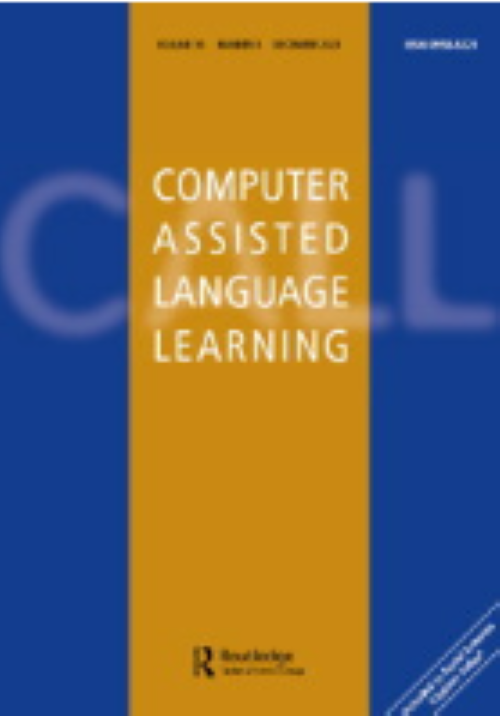Predicting attitude, use, and future intentions with translation websites through the TAM framework: a multicultural study among Saudi and South Korean language learners
IF 6.6
1区 文学
Q1 EDUCATION & EDUCATIONAL RESEARCH
引用次数: 0
Abstract
AbstractMachine translation (MT) practice and activity development in education are possible when students with diverse backgrounds contribute to helping define how MT can best be used for language learning. This study employed a questionnaire based on an adapted version of the technology acceptance model (TAM) to gain perspective on the perceptions, attitudes, and use of MT tools like Google Translate among Saudi and Korean university students learning English as a foreign language (EFL). A total of 470 students were recruited from Saudi Arabia and South Korea to complete a questionnaire measuring scales on perceived ease of use, perceived usefulness, attitude, actual use, and intended future use of MT websites. Structural equation modeling analyzed the relationships among the TAM variables. Results found that Saudi and Korean students both reported high levels on the TAM variables, indicating that translation tools were easy to use and useful for studying language. Lower L2 proficiency correlated with greater perceived usefulness and a more positive attitude. Students frequently use MT tools when learning English and plan to continue using them in the future. The model explained 71% of actual use and 42% of behavioral intention to use MT for language learning. Furthermore, Saudi students reported a slightly easier time using MT tools for language learning, while Korean students planned to use MT more often. Other findings, along with practical applications, are presented in this paper.Keywords: Machine translationGoogle Translatetechnology acceptance modelEnglish as a Foreign Language computer-assisted language learning Disclosure statementNo potential conflict of interest was reported by the author(s).Data availability statementAvailable upon request.Additional informationFundingThe authors extend their appreciation to the Deanship of Scientific Research, Imam Mohammad Ibn Saud Islamic University (IMSIU), Saudi Arabia, for funding this research work through Grant No. (221407008).通过TAM框架预测翻译网站的态度、使用和未来意图:沙特和韩国语言学习者的多元文化研究
摘要当不同背景的学生参与定义机器翻译在语言学习中的最佳应用时,机器翻译在教育中的实践和活动发展是可能的。本研究采用了一份基于技术接受模型(TAM)的调查问卷,以获得沙特和韩国大学生学习英语作为外语(EFL)时对谷歌翻译等机器翻译工具的看法、态度和使用的看法。从沙特阿拉伯和韩国共招募了470名学生,完成了一份MT网站的感知易用性、感知有用性、态度、实际使用和预期未来使用量表的问卷调查。结构方程模型分析了TAM变量之间的关系。结果发现,沙特和韩国学生都报告了高水平的TAM变量,这表明翻译工具易于使用并且对学习语言有用。较低的第二语言熟练程度与较高的感知有用性和更积极的态度相关。学生在学习英语时经常使用MT工具,并计划在未来继续使用它们。该模型解释了使用机器学习进行语言学习的71%的实际使用和42%的行为意图。此外,沙特学生报告说,在语言学习中使用机器翻译工具稍微容易一些,而韩国学生计划更频繁地使用机器翻译。本文还介绍了其他研究结果以及实际应用。关键词:机器翻译谷歌翻译技术接受模型英语作为外语计算机辅助语言学习披露声明作者未报告潜在的利益冲突。数据可用性声明可根据要求提供。作者感谢沙特阿拉伯伊玛目穆罕默德·伊本·沙特伊斯兰大学(IMSIU)科学研究部主任通过第5号拨款资助本研究工作。(221407008)。
本文章由计算机程序翻译,如有差异,请以英文原文为准。
求助全文
约1分钟内获得全文
求助全文
来源期刊

Computer Assisted Language Learning
Multiple-
CiteScore
18.50
自引率
12.90%
发文量
74
期刊介绍:
Computer Assisted Language Learning (CALL) is an intercontinental and interdisciplinary journal which leads the field in its dedication to all matters associated with the use of computers in language learning (L1 and L2), teaching and testing. It provides a forum to discuss the discoveries in the field and to exchange experience and information about existing techniques. The scope of the journal is intentionally wide-ranging and embraces a multitude of disciplines.
 求助内容:
求助内容: 应助结果提醒方式:
应助结果提醒方式:


